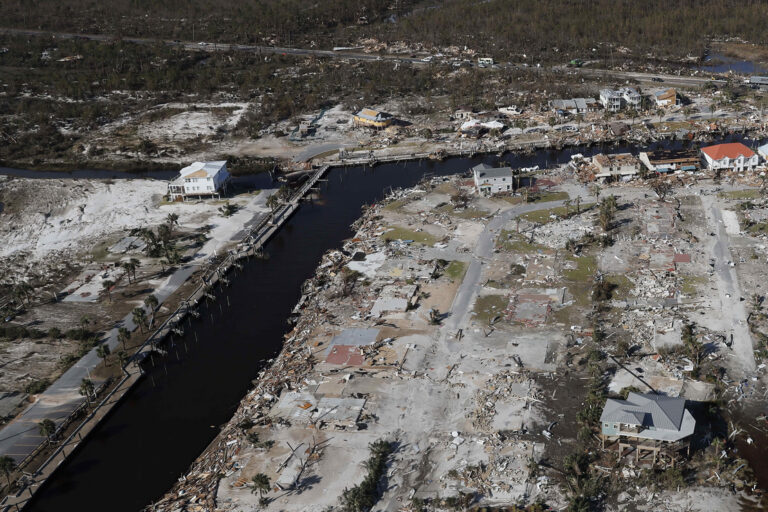Devastation from Hurricane Michael is visible in Mexico Beach, Fla., in 2018. Gerald Herbert/AP
A long-awaited federal climate report, released Tuesday, delivers a blunt warning: Rapidly curb planet-warming emissions or face dire consequences to human health, infrastructure and the economy.
The fifth installment of the National Climate Assessment presents the most comprehensive evaluation to date of U.S. climate science, impacts and action. Dozens of authors, including representatives from multiple federal agencies, contributed to the congressionally mandated report.
The assessment details how climate change is already battering the nation with extreme heat, hurricanes, wildfires, droughts, floods and swiftly rising sea levels. It estimates that “billion-dollar disasters” are happening every three weeks on average — up from every four months in the 1980s.
U.S. youth are growing up amid these realities, said White House National Climate Adviser Ali Zaidi on a call with reporters last week.
“Billion-dollar disasters” are happening every three weeks on average — up from every four months in the 1980s.
—National Climate Assessment
“They have not just intellectually started to appreciate the concept of this crisis — it is their lived experience to see the sky turn orange, to breathe in the smoke from wildfires hundreds of miles away, to see lives and livelihoods washed away by floods and the fury of hurricanes,” he said.
But he emphasized that the report’s takeaway “should be a sense of hope and possibilities.”
“We’ve got climate solutions that can be made in America and are being made in America that we’re deploying brick by brick and block by block,” he said. “That gives us hope.”
The new assessment is the first such report released under the Biden administration, which has made climate change a centerpiece of its agenda. It comes as the world has already warmed by more than 1 degree Celsius since the preindustrial era, with greenhouse gas concentrations in the atmosphere higher than at any point in at least the last 800,000 years.
Every corner of the country is now experiencing the consequences of global warming, often in different ways. Extreme precipitation and flooding is on the rise in the Northeast, while drought and wildfires are worsening in the West. Sea levels are rising significantly faster than the global average in the Southeast, and strengthening Atlantic hurricanes are a growing threat to the East and Gulf coasts.
Low-probability and potentially catastrophic outcomes are not impossible, and these risks persist even under current policies. How much more the world warms depends on the choices societies make today. The future is in human hands.
—National Climate Assessment
Rapid warming, melting sea ice and thawing permafrost are transforming the Alaskan landscape, disproportionately threatening Indigenous communities and disrupting cultural practices and traditions. Sea-level rise and saltwater intrusion are growing threats to freshwater supplies in Hawaii and U.S. Pacific territories.
And with every fraction of a degree that the climate warms, more damage and greater economic losses will follow, the report warns.
“Low-probability and potentially catastrophic outcomes are not impossible, and these risks persist even under current policies,” the report says, later adding: “How much more the world warms depends on the choices societies make today. The future is in human hands.”
While U.S. emissions are falling — dropping by 12 percent between 2009 and 2019 — far more dramatic cuts are needed, according to the assessment. The country’s emissions would need to fall by about […]
Full article: www.eenews.net

